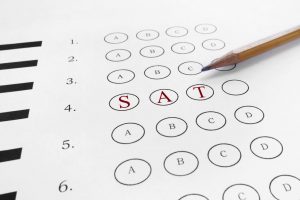

Fill-in-the-blank questions without answer choices can be challenging for some students.
FILL-IN-THE-BLANK QUESTIONS account for about 22% of the total 58 questions in the SAT Math section. Unlike multiple-choice questions, where answer options are provided, fill-in-the-blank questions require students to generate their own answers.
These questions appear in both the calculator and non-calculator sections. To complete these questions, students must know how to solve the problem to arrive at the correct answer. When filling in the blanks, note that each box corresponds to a single digit or character. A comma in a number counts as a character, and students must fill it in a separate box.
Students can visit the College Board website for guidance on how to fill in answers: https://www.collegeboard.org/node/4486
The lack of provided answer choices can be a challenge for some students. To better prepare, let’s review three common mistakes students often face and how to avoid them:
Although SAT Math tests have different names and formats, fill-in-the-blank questions are quite similar to multiple-choice questions. In fact, all these questions follow the same process: Start by considering the given and needed data, then choose the appropriate method to arrive at the required answer.
Multiple-choice questions tend to include tricks. Therefore, instead of immediately choosing an answer, students should use their existing knowledge to derive their own answer first. Only look at the answer choices after you have an answer, and then you can quickly eliminate incorrect options.
Fill-in-the-blank questions also require a similar approach to other math questions. Identify the useful information and the process or formula that can be used to answer the question. The key factor with fill-in-the-blank questions is to take a few seconds to fill in the answer carefully.
Students should be mindful of allocating extra time to fill in their answers. This extra time does not mean that fill-in-the-blank questions are harder than multiple-choice questions. It simply means students need to be careful when filling in their answers.
To get accustomed to time management for fill-in-the-blank questions, practice timed tests. Try to complete a series of these questions consecutively, so students can develop this skill.
Avoid wasting time studying complicated instructions on how to fill in answers. These instructions should be secondary resources to ensure that students do not spend too much time recalling them during the SAT.
Checking your answer is a step students should take once they have their final result.
For example, correct answers will never be negative. If a student solves a problem and gets a negative result, it’s a clear sign that something went wrong. Therefore, double-check your work to find a more accurate answer.
Another clear sign is overly large percentages or fractions. For example, consider the following problem: “The table below classifies 103 elements as metal, metalloid, or nonmetal and as solid, liquid, or gas at standard temperature and pressure. Of the 90 solids, 77 are metals, seven are metalloids and six are nonmetals. Of the two liquids, one is a metal and one is a nonmetal. Of the 11 gases, all are nonmetals.”
The question is: “What fraction of all solids and liquids in the table are metalloids?”
The student’s answer should be less than 1 because 1 would mean that 100% of the solids and liquids in the table are metalloids, which is not the correct answer. Therefore, if a student calculates 92/7 or similarly high fractions, it’s a sign that there was an error somewhere in their work.
Another common mistake is forgetting that the sum of the angles in a triangle always equals 180 degrees. Always double-check that your answer aligns with general knowledge you’ve learned previously.
The apprehension towards these questions often stems from a misunderstanding of the question type. Once students grasp the guidelines for fill-in-the-blank questions, many will realize that these questions are not as challenging as they initially seemed.